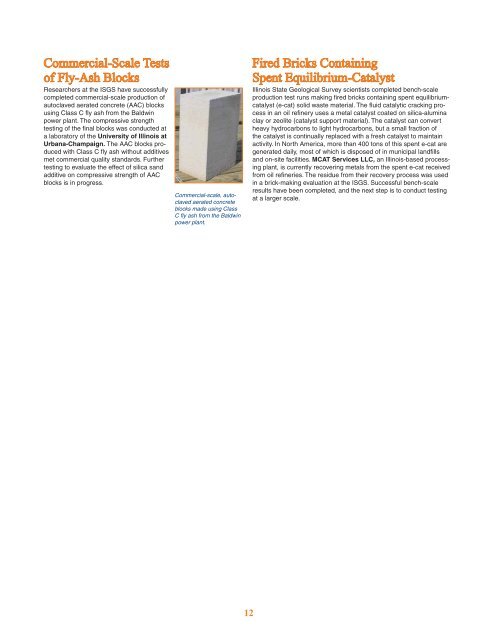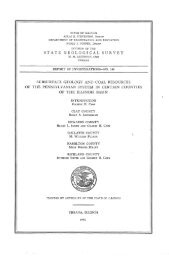2008 ISGS Annual Report - University of Illinois at Urbana-Champaign
2008 ISGS Annual Report - University of Illinois at Urbana-Champaign
2008 ISGS Annual Report - University of Illinois at Urbana-Champaign
You also want an ePaper? Increase the reach of your titles
YUMPU automatically turns print PDFs into web optimized ePapers that Google loves.
Commercial-Scale Tests<br />
<strong>of</strong> Fly-Ash Blocks<br />
Researchers <strong>at</strong> the <strong>ISGS</strong> have successfully<br />
completed commercial-scale production <strong>of</strong><br />
autoclaved aer<strong>at</strong>ed concrete (AAC) blocks<br />
using Class C fly ash from the Baldwin<br />
power plant. The compressive strength<br />
testing <strong>of</strong> the final blocks was conducted <strong>at</strong><br />
a labor<strong>at</strong>ory <strong>of</strong> the <strong>University</strong> <strong>of</strong> <strong>Illinois</strong> <strong>at</strong><br />
<strong>Urbana</strong>-<strong>Champaign</strong>. The AAC blocks produced<br />
with Class C fly ash without additives<br />
met commercial quality standards. Further<br />
testing to evalu<strong>at</strong>e the effect <strong>of</strong> silica sand<br />
additive on compressive strength <strong>of</strong> AAC<br />
blocks is in progress.<br />
Commercial-scale, autoclaved<br />
aer<strong>at</strong>ed concrete<br />
blocks made using Class<br />
C fly ash from the Baldwin<br />
power plant.<br />
12<br />
Fired Bricks Containing<br />
Spent Equilibrium-C<strong>at</strong>alyst<br />
<strong>Illinois</strong> St<strong>at</strong>e Geological Survey scientists completed bench-scale<br />
production test runs making fired bricks containing spent equilibriumc<strong>at</strong>alyst<br />
(e-c<strong>at</strong>) solid waste m<strong>at</strong>erial. The fluid c<strong>at</strong>alytic cracking process<br />
in an oil refinery uses a metal c<strong>at</strong>alyst co<strong>at</strong>ed on silica-alumina<br />
clay or zeolite (c<strong>at</strong>alyst support m<strong>at</strong>erial). The c<strong>at</strong>alyst can convert<br />
heavy hydrocarbons to light hydrocarbons, but a small fraction <strong>of</strong><br />
the c<strong>at</strong>alyst is continually replaced with a fresh c<strong>at</strong>alyst to maintain<br />
activity. In North America, more than 400 tons <strong>of</strong> this spent e-c<strong>at</strong> are<br />
gener<strong>at</strong>ed daily, most <strong>of</strong> which is disposed <strong>of</strong> in municipal landfills<br />
and on-site facilities. MCAT Services LLC, an <strong>Illinois</strong>-based processing<br />
plant, is currently recovering metals from the spent e-c<strong>at</strong> received<br />
from oil refineries. The residue from their recovery process was used<br />
in a brick-making evalu<strong>at</strong>ion <strong>at</strong> the <strong>ISGS</strong>. Successful bench-scale<br />
results have been completed, and the next step is to conduct testing<br />
<strong>at</strong> a larger scale.

















